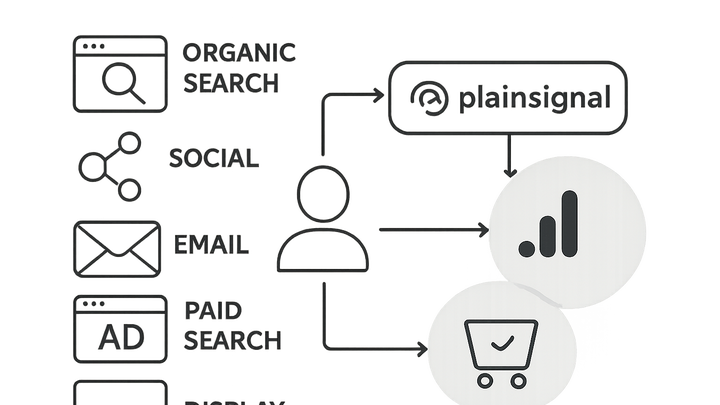Published on 2025-06-26T04:43:46Z
What is Last Touch Attribution? Examples in GA4 and PlainSignal
Last Touch Attribution, also known as Last Interaction Attribution, is an analytics methodology that assigns full credit for a conversion event to the final touchpoint a user engages with before converting. In the analytics industry, this model simplifies performance analysis by focusing exclusively on the last user interaction, whether it’s a paid ad click, email engagement, or organic search click. Platforms like Google Analytics 4 (GA4) provide built-in support for last touch reporting, while lightweight, cookie-free solutions such as PlainSignal can be configured to capture and attribute the final touch in privacy-compliant environments. Though straightforward, this model may overlook the influence of earlier touchpoints and thus can skew strategic decisions if used in isolation. Nevertheless, Last Touch Attribution remains a widely adopted technique for marketers seeking quick insights into which channels seal the deal. By understanding its mechanics, benefits, and limitations, analytics teams can make informed decisions about when to apply this model and when to opt for more comprehensive multi-touch approaches.
Last touch attribution
An analytics model that credits the final user interaction before conversion, used in GA4 and PlainSignal for quick insights.
What is Last Touch Attribution?
An in-depth look at Last Touch Attribution, its definition, and when marketers typically use it.
How It Works
This section explains how analytics platforms capture touchpoints and assign credit using the last touch model.
-
Touchpoint recording
Analytics tools record each user interaction—such as pageviews, ad clicks, and email opens—via tracking pixels or scripts.
-
Credit assignment
Upon a conversion event, the model assigns 100% of the credit to the last recorded interaction.
Benefits and Use Cases
Explores the advantages of using Last Touch Attribution and scenarios where it delivers clear value.
-
Simplicity and clarity
By focusing on a single touchpoint, it provides straightforward insights that are easy to interpret and communicate.
-
Optimizing direct response campaigns
Ideal for campaigns with immediate conversion goals, where the final touch is a strong indicator of performance.
Limitations and Considerations
Highlights the potential biases and blind spots inherent in the Last Touch Attribution model.
-
Ignores early engagements
Misses contributions from earlier touchpoints that may have influenced the user’s decision.
-
Bias toward certain channels
May overvalue channels commonly serving as final interactions, such as direct or remarketing traffic.
Implementation Examples
Step-by-step examples of configuring Last Touch Attribution in GA4 and PlainSignal.
-
Google analytics 4 (GA4)
Ensure your site includes the GA4 gtag snippet:
<script async src="https://www.googletagmanager.com/gtag/js?id=G-XXXXXXXXXX"></script> <script> window.dataLayer = window.dataLayer || []; function gtag(){dataLayer.push(arguments);} gtag('js', new Date()); gtag('config', 'G-XXXXXXXXXX'); </script>Then, access the Model Comparison Tool under Advertising > Attribution to view Last Touch reports.
-
PlainSignal (cookie-free analytics)
Add the following snippet to your site’s
<head>or footer to enable PlainSignal tracking and last touch attribution:<link rel="preconnect" href="//eu.plainsignal.com/" crossorigin /> <script defer data-do="yourwebsitedomain.com" data-id="0GQV1xmtzQQ" data-api="//eu.plainsignal.com" src="//cdn.plainsignal.com/plainsignal-min.js"></script>Then, view the Last Touch report in the PlainSignal dashboard to see which interactions closed conversions.
Alternatives to Last Touch Attribution
Overview of other attribution models that distribute credit differently across user touchpoints.
-
First touch attribution
Assigns 100% of the conversion credit to the first touchpoint a user encountered.
-
Linear multi-touch attribution
Distributes credit equally across all touchpoints in the user journey.
-
Time-decay attribution
Gives higher credit to touchpoints closer in time to the conversion.
-
Data-driven attribution
Uses machine learning to allocate credit based on how past interactions influence conversions.
